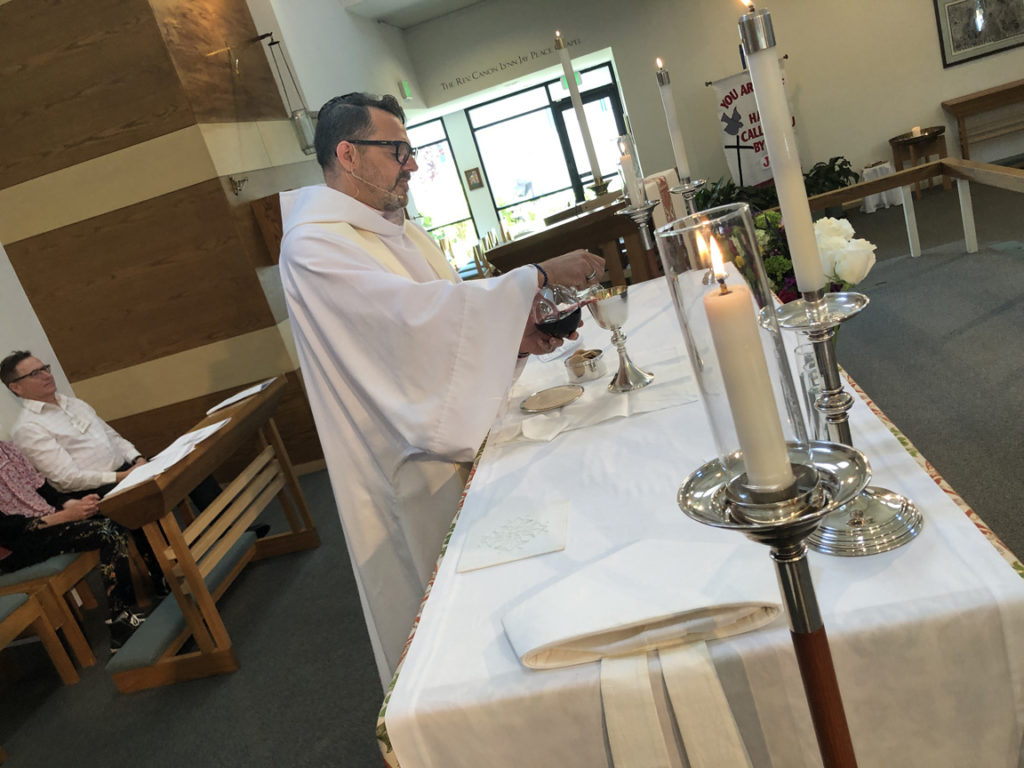 Midsummer greetings and blessings from St. Paul’s Commons, Echo Park. I’m writing with a couple of new wrinkles in the fair linen, namely some guidance about practices and procedures for Holy Eucharist.
Midsummer greetings and blessings from St. Paul’s Commons, Echo Park. I’m writing with a couple of new wrinkles in the fair linen, namely some guidance about practices and procedures for Holy Eucharist.
The first is mostly for review. At the following link, you’ll find the March 2022 message from the Bishop’s Commission on Liturgy and Music of the Episcopal Diocese of Los Angeles, offering a range of options for serving wine during communion – individual cups, intinction, and the common cup: Click here.
All these options remain. But we recently revised the first. The portion in italics is new:
After the Breaking of the Bread, using the flagon of consecrated wine to fill small, individual chalices (cups) and distributing them to the people in the manner customary for the parish (by lay persons, deacons, or priests), or fill the cups from the reserved sacrament and place them on the credence table, distributing the cups to communicants after the prayer of consecration and the fraction. The wine consecrated in a single flagon during the service can be used for the cups the following week.
In the spirit of our Anglican traditions, we ask that you not pour unconsecrated wine in individual cups. Yet filling the cups after the consecration can be time-consuming. The new option was the brainchild of parish leaders at St. Mark’s in Downey.
My second note concerns the issue of the open table: Offering communion to those who may not yet be baptized. While the canons of The Episcopal Church say baptism is a prerequisite, a number of our missions and parishes have open tables. The Episcopal Church will continue to debate this question, including, we expect, at General Convention next summer in Louisville. Open table proponents stress the core Christian ethic of hospitality. Some proponents of following the canon fear we risk welcoming newcomers for a mere wafer and sip of wine instead of the profound encounter with the risen Christ just a little teaching can enable.
For now, we all have a responsibility to respect the canons of the Church as well as the dictates of our consciences. In consultation with the Rev. Canon Susan Russell, diocesan staff liaison with the liturgy and music commission, I have prepared the rubric below. I ask that all missions and parishes which have established an open table policy print it in their bulletins each week:
By tradition, The Episcopal Church offers Holy Communion to all baptized persons. If you are not baptized, but wish to receive, we invite you to participate fully in the opening part of the service, called the Ministry of the Word, hearing God’s word and reflecting on your life, enabling you to come to the table for communion, if you so choose, with a heart prepared to receive. We hope that if you feel touched by the word and sacrament and wish to learn more about the life-giving power of the Spirit of the Risen Christ, you will contact [insert name] to inquire about participating in Holy Baptism.
Again, this is just for missions and parishes with open eucharistic tables. It is not an invitation to alter your practice. Nor is the rubric designed to replace or supersede the language you may already use during the liturgy to invite people to come be served.
If you have any questions or comments about either of these matters, please drop me a line at jtaylor@ladiocese.org.
We sent this pastoral letter this week to lay and ordained leaders at our missions and parishes. I reproduce it here for for the sake of everyone who loves liturgy. If you are a congregational leader, but you didn’t get the email, please let me know. The photo shows the Very Rev. Christopher Montella setting the table in July at St. Stephen’s Episcopal Church Santa Clarita, Ca, where he serves as rector.
